July 1, 2021 – Hayden Meadows (Between the parking lot and the Rt 24 bridge)
Flows: 232 cfs
Water Temp: 56F
Water clarity: Slightly off-color ~4’.
Air Temp: ~50F @ 8:30a, 65 @ 5p.
Hatches: Caddis: Heavy all day. Midge: 9a – 2p, PMD & BWO: 11:30a – 1p, Grey Drake: 12N – 1p.
Flies: #10 Chubby Chernobyl, #16 Red Copper John, #16 Black Copper John, #22 Black Pheasant Tail, #20 BH Tan Caddis Pupae, #20 Chartreuse Graphic Caddis, #18 Sparkle Dun, #20 Parachute Adams, #18 Pheasant Tail, #20 Puterbaugh Caddis, #20 Elk Hair Caddis, #18 Parachute Adams.
Top producers: Chubby Chernobyl, Parachute Adams, Sparkle Dun, Copper Johns, Pheasant Tail, Caddis Pupae.
A view of Mt. Massive from the parking lot.
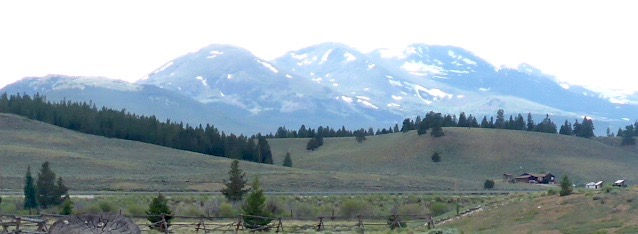
Spring run off – what little we had this year in Colorado – is winding down. For the fisherman, that means there is more fishable water and more choices of rivers to fish. That’s how Brian and I ended up at Hayden Meadows fishing the Upper Arkansas River. The flows were at an ideal level at less than 250 cubic feet per second (cfs). We’ve been kind of boxed in to fishing the South Platte for the past month or so – anxiously waiting for more rivers to open up.
The South Platte is a great fishery. Fly fishermen would give their left arm – or even more – to be able to fish it on a regular basis. But after fishing it so many times – we wanted to try something different. This is a good thing. Fishing new and different rivers provides new challenges and experiences which helps to expand and hone your fishing expertise. It also gives you a deeper perspective on fly fishing and the different rivers.
An approaching storm - the clouds obscuring Mt. Elbert.

We had been watching the Ark – waiting for the flows to subside. Our focus was on the Lower Ark – near Canyon City. But we ended up at the Upper Ark - fishing the headwaters of the river which is formed by snow melt in the Sawatch and Mosquito Mountain Ranges. This section of the river meanders through the valley between these ranges with no dams or man made obstructions – what is referred to as a “free stone” river.
The Arkansas is on the eastern side of the Continental Divide. Which means the river eventually flows into the Atlantic Ocean. The Continental Divide is not a straight line through the Rocky Mountains – rather is zigzags it’s way from north to south dividing the river flows between the Atlantic and Pacific Oceans. The Arkansas flows southeast and feeds into the Mississippi River.
Another view of Mt. Massive and parts of the Sawatch Range.

We were about 10 miles south of Leadville, Colorado – an old mining town that was established in the late-1800’s - when gold and a lead mineral high in silver content was found there. The town is quaint with buildings from the 1800s lining it’s main street. This is the high country – the city of Leadville sits at 10,151’ and is the highest city in the US.
We arrived at the Hayden Meadows parking lot at about 8:30a with the Sawatch Mountain Range towering to the west. The highest mountain in Colorado and the 2nd highest in the continental US – Mount Elbert – is part of this range. As is Mount Massive – the 2nd highest mountain in Colorado. In all, the range has eight peaks over 14,000’. There were storm clouds along the peaks – even in the morning when we arrived - obscuring the view of the peak of Mt. Elbert. Still it was quite a sight.
An adult caddis. There were so many hatching - at times they resembled confetti.

For fishing purposes, the Arkansas River is broken down into four sections. The Upper, Middle, Lower, and the Pueblo Tailwater. I did some recon on this section of the river – chatting with local guides and reading up on the latest fishing reports. There were various types of bugs reported to be actively hatching and coupled with the ideal flows – the reports stated this was the best time to fish the Upper Ark. The guidance I got was to start at the parking lot and move upstream. So that’s what we did.
The first hole we fished was at the bridge down the path from parking lot. I was above the bridge and Brian was below it. The river was a bit off color making it difficult to sight fish. After a bit with no action, we decided to head upstream. We soon found out that this is a very hard river to navigate. It has to have the roundest, slipperiest rocks known to man. So wading is very difficult. And the vegetation along the bank is thick - very thick – with only deer trails through it. We found that deer could get through it – but we couldn’t. Especially with 9’ fly rods in hand.
Brian fishing the Daily Double before the storm.

We had to hike away from the river and soon found ourselves in the swampy area that one of the guides told me that Hayden Meadows is known for. As we were driving up – I mentioned this to Brian and we noted that we better get the bug spray out. But as we slogged our way through it – I remembered that I forgot to use it! Those little mosquitoes love me – and I paid the price for being forgetful!
After slogging through the swamp, we found a spot in the brush that got us back to the river. With the murky water, and unable to sight fish we had to pick spots that looked fishy. And the spot we came upon looked just like that. But after several drifts through it with no hits – I decided to scout upstream to see if I could spot any fish.
They were eating stones. This was my 1st catch of the day.

The other “book” on this part of the river is to fish the banks. The river bends and twists it’s way through the meadow and the banks along these bends are usually deep and cutout. So that’s where I was looking as I walked along the bank upstream. I finally spotted some fish. As expected, they were along the bank and I spooked them. As I scoped the river, it was apparent that we needed to fish it from the other side.
I went back and told Brian that I found a spot that’s holding fish – but we had to cross the river to fish it. Crossing the river was not going to be easy especially with all those slippery rocks. So we began to walk upstream looking for a place that we thought we could cross without taking a swim. Brian suggested a spot. It was not easy, but we both made it across without getting wet.
Caddis pupae found under this rock. This part of the river is known for it's plentiful caddis and stoneflies.
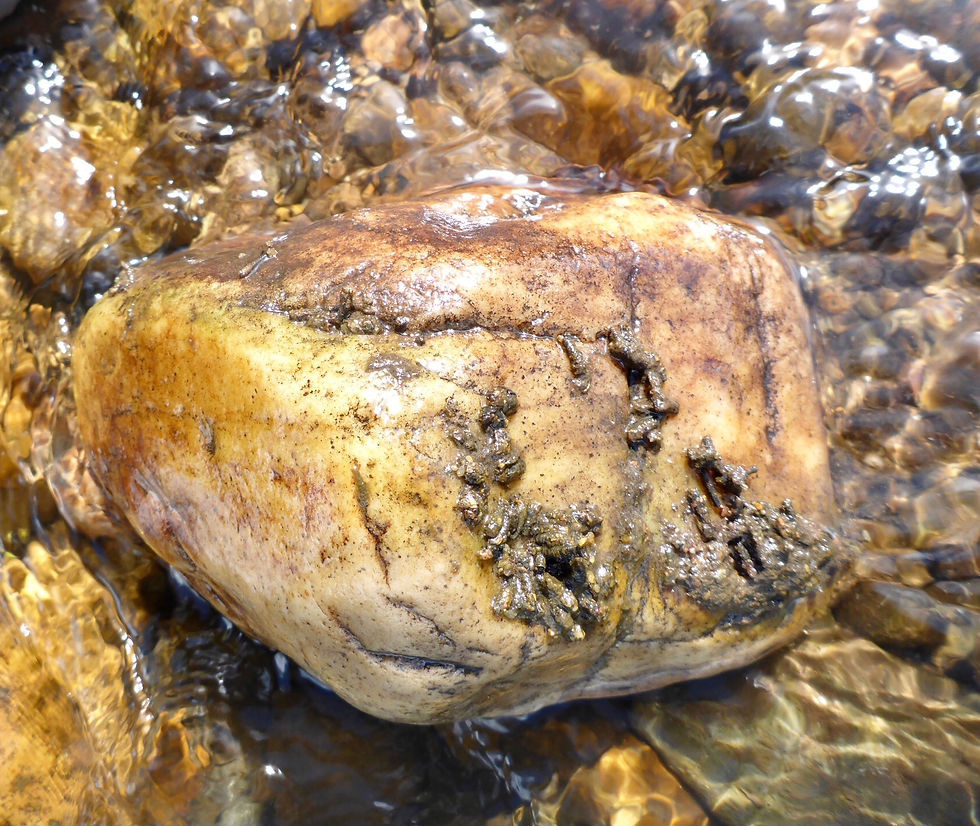
Once on the other side, we were faced with the same thick vegetation along the bank. So we had to wade along the side of the river back downstream until we got to the place where I spotted the fish. This ordeal took us about ½ hour – so I wasn’t too worried about the fish still being spooked. But I was asking myself if that hike and wade was going to be worth it.
It was.
On my second cast into the zone I had a fish on. It was a brownie that measured 13 ½ inches. He hit the Pat’s Rubber Leg. Stoneflies were on the menu. We weren’t expecting big fish. The average fish caught in this section of the river is between 14” and 16” – with the occasional larger ones in the 18” range. Most of them brownies.
Brian got this beaut in the Daily Double Hole.
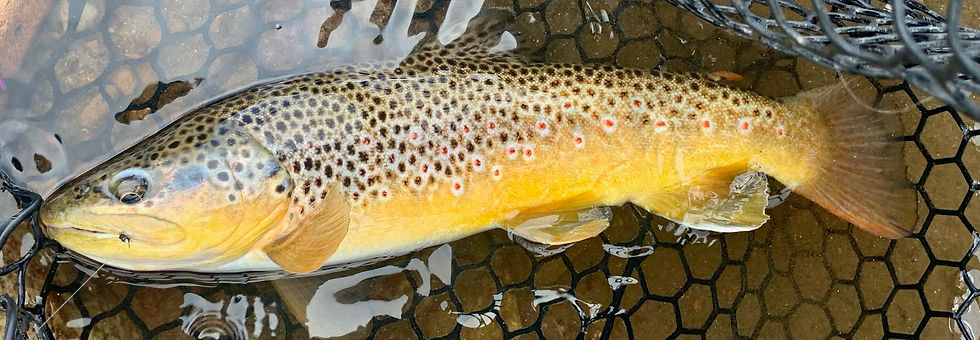
Brian Kenney.
The bug activity was as advertised. The caddis were so thick it was like we were standing in the middle of confetti being thrown. They were smaller than what we’ve seen before – but they were all over the place. The interesting thing was – the fish weren’t rising for them and didn’t seem interested in my caddis pupae. I had it following my Pat’s. It was chartreuse and maybe they were looking for a tan one? I think this may have been the case, as Brian landed one on a tan bead head caddis pupae.
Soon there were PMDs, midges, and Grey Drakes hatching along with the throng of caddis.
This one took the Pheasant Tail - a hot fly for me on this day.
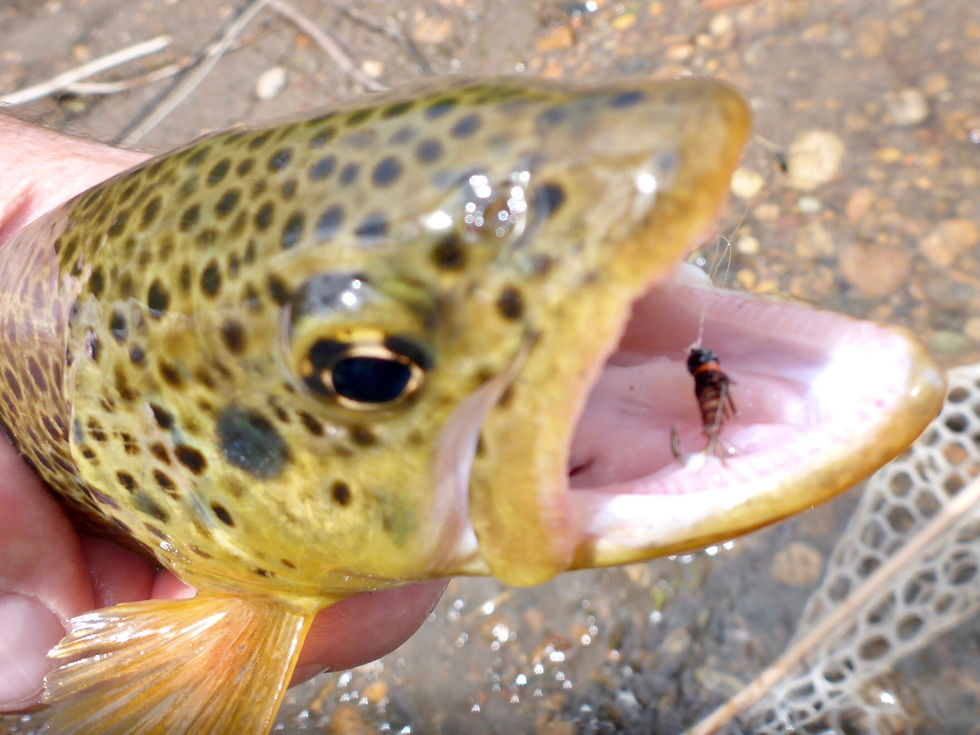
Another nugget of advice from the fishing reports was to use a Dry/Dropper rig - one of my favorites. But the flows seemed too high for that. So Brian and I were both fishing a regular nymph rig and we both caught a few fish each before lunch. All brownies in the 14” range – except for a cutbow that Brian caught - it was 16”. A nice catch.
As we ate our lunch streamside, we noticed a few fish were starting to come up to eat adult flies. And there was a storm approaching from the west. At first, they looked like small fish rising. Then we saw a few that didn’t seem so small.
That’s when I decided to break from lunch and tie on some dries. With all the caddis hatching my choices were a Puterbaugh Caddis and an Elk Hair Caddis. But none of the trout were interested in them. Brian soon followed me – he had on a Chubby Chernobyl and a Grey Parachute Adams.
Another nice brownie landed by Brian.
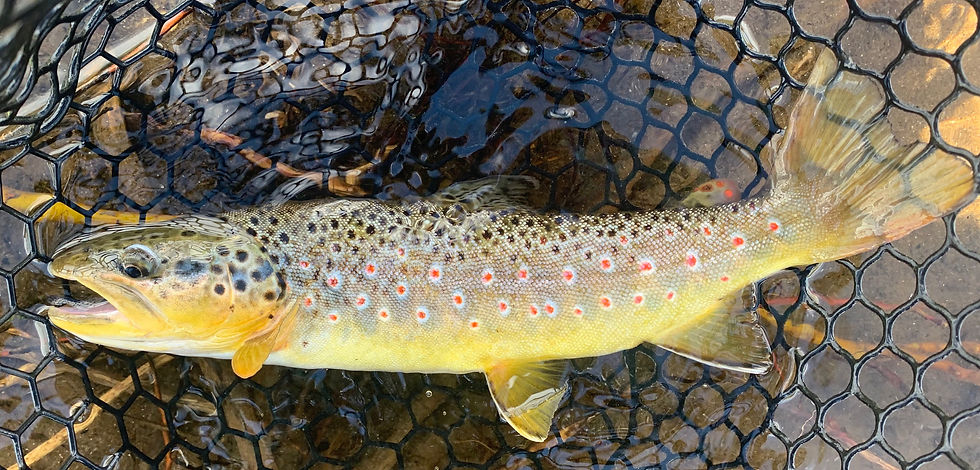
Brian Kenney.
This is when the hole – which I named The Daily Double – turned on. The reason I named it The Daily Double? As Brian continued to drift his flies into the zone of the rising fish, he called out “I got him”. He said he saw the fish rise and gobble up his Chubby. But as he was bringing the fish in he noticed that he had another fish on too. That one hit his Sparkle Dun.
Are you kidding me? Two fish on at the same time! I’ve heard of this happening but never witnessed it. The brownie that hit his Chubby was 17” and the other one was 14”. Quite a feat!!
Here's Brian holding a 17" brownie. This is one of the 2 fish he pulled in at the same time!

Brian Kenney.
We’re standing in the middle of the first thunderstorm – yes there was another one later! – and fish were rising. I’m not sure what turned them on – but I think it was the Grey Drakes. The caddis were hatching all day long with minimal attention. Then as soon as we began to see the PMDs and Drakes – we see fish rising all over the place.
With the storm in full force – rain and high wind – I was changing my flies. Attempting to that is. When the wind is blowing hard – it is best to keep your flies in the water. But I wanted to change mine up. The caddis weren’t getting it done. I picked a #18 Parachute Adams and a Chubby Chernobyl to tie on – leaving my caddis on as the third fly. I had everything tied on and was getting ready to apply some floatant to the flies when the wind grabbed my caddis and proceeded to whip it around. The next thing I knew I had a mother of a granny knot in my hands.
My patience paid off. I finally got this one on my Chubby after just as the rising was about to stop.
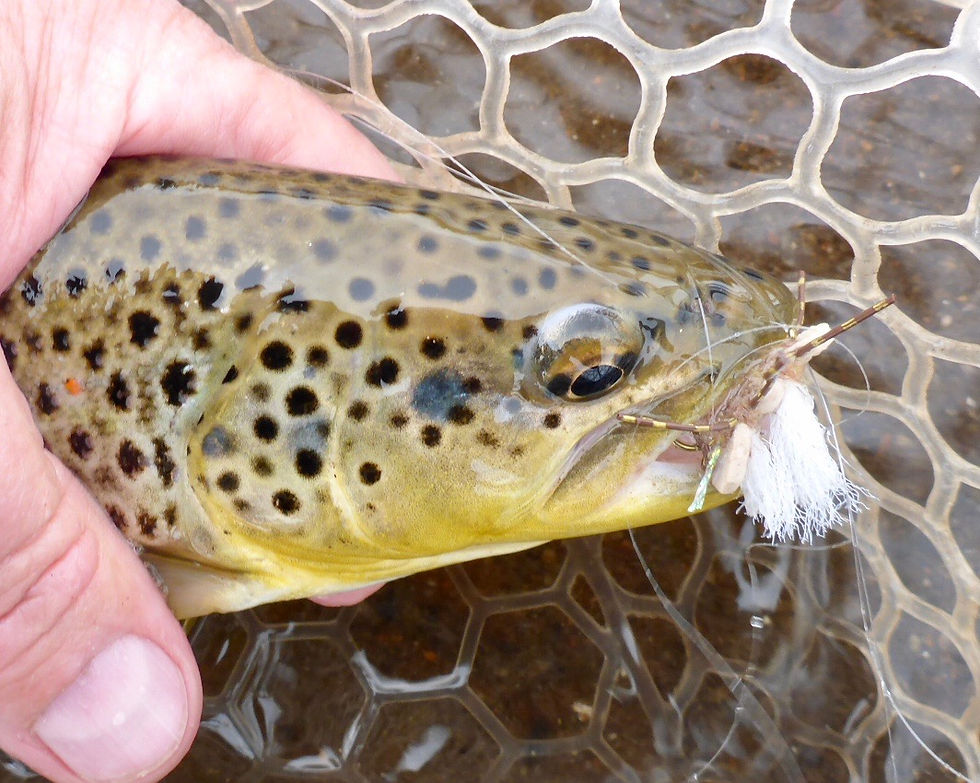
As I tried to untangle it – I knew time was of the essence. Rising fish, gobbling adult insects doesn't last forever. And I was very pissed off that here I am messing with a huge tangle while the bite it on. And as soon as I would get one tangle out – I’d get another. Everything was whipping in the wind!
Finally done – I casted my flies into the water as Brian mentions that the rising is subsiding. Ugh! On my second cast though I got a nice brown to take ----- but I missed him. At this time I think steam might have been coming out of my ears!
Stoneflies pumped from one of the brownies stomachs.

But I patiently worked the water and I finally had a brownie come up and hit my Chubby. Finally – I had one on a dry. Then just like that – it was over. I’m laughing now – it’s just the way the ball bounces some time. Even with the monster knot and missing most of the action trying to untie it – it was an amazing experience. I’ve never seen so many different flies hatching at one time.
With the rising over and no more action on nymphs we decided to head further upstream. Even though we didn’t need to cross the river – we still had to fight our way out of the thick vegetation to get to a place above the river so that we could walk upstream. We found a spot that looked fishy and even though we couldn’t spot any fish we wanted to try it. And wouldn’t you know it --- we would have to cross the river to fish it!
A female brownie taken out of the Tree Hole.
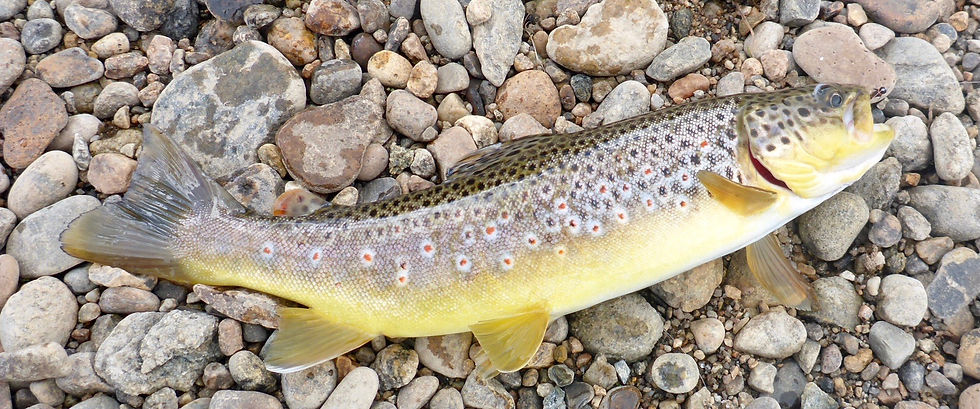
We decided to go further upstream to find a crossing place. On the way we ran into another fishy spot and decided to give it a try. We were about 1/8 of a mile downstream of the bridge just below a pool. Brian began fishing into it and I was further downstream casting to the opposite bank. It wasn’t long and I had a few more brownies on. They were hitting the Pheasant Tail.
I’m pretty sure no one has named the various holes, pools, and runs along this part of river. If they have, I’m not aware of it. For us, this spot is now known as the Lower 24 Bridge Run.
This one took Brian's Black Pheasant Tail. Black was the color for awhile.
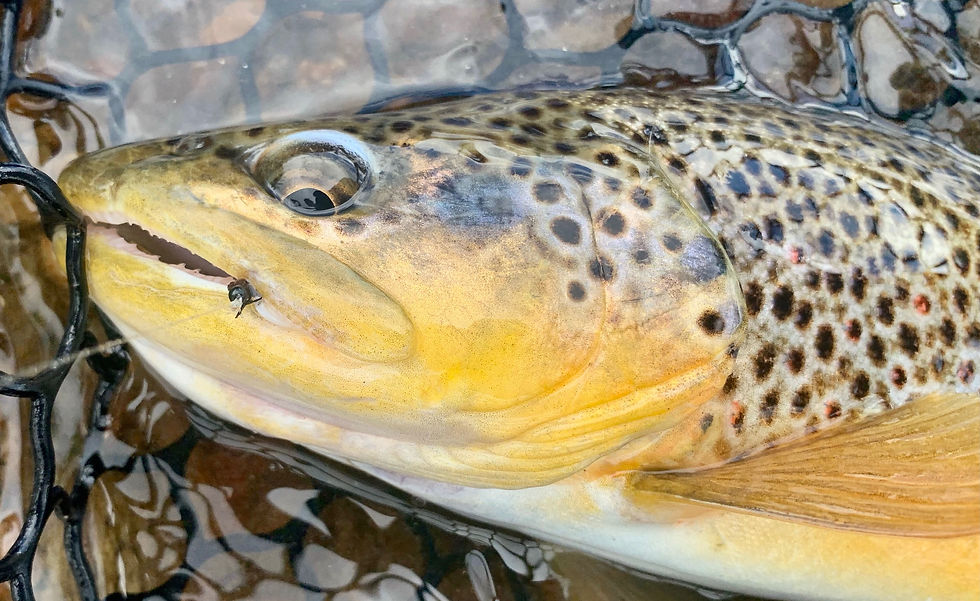
Brian Kenney.
After a bit, Brian went upstream and found a good crossing point. I soon followed and we worked our way back to the spot we originally wanted to try. This one is now called the Tree Hole. And the damned tree has a very beautifully tied Black Copper John stuck into one of it’s branches – courtesy of me!
We were able to land several fish each in The Tree Hole and the run below it. They were hitting the Pheasant Tail and the Black Copper John. Yes the same one ---- before I got it stuck in the tree! These brownies were all in the 13” to 14” range – except for one that I got. He was more like 10” – but very beautifully colored.
As I was tying on a fly to replace my Copper John, Brian headed downstream. As soon as I was done, I would follow. After tying my fly on, I looked up and Brian was nowhere in sight. Lost in the thick vegetation. I soon found him – he was in the Confluence Hole. This was the fishy spot we tried earlier in the day after slogging through the marsh.
A 10" beauty. She aggressively hit the Black Copper John in the Tree Hole.
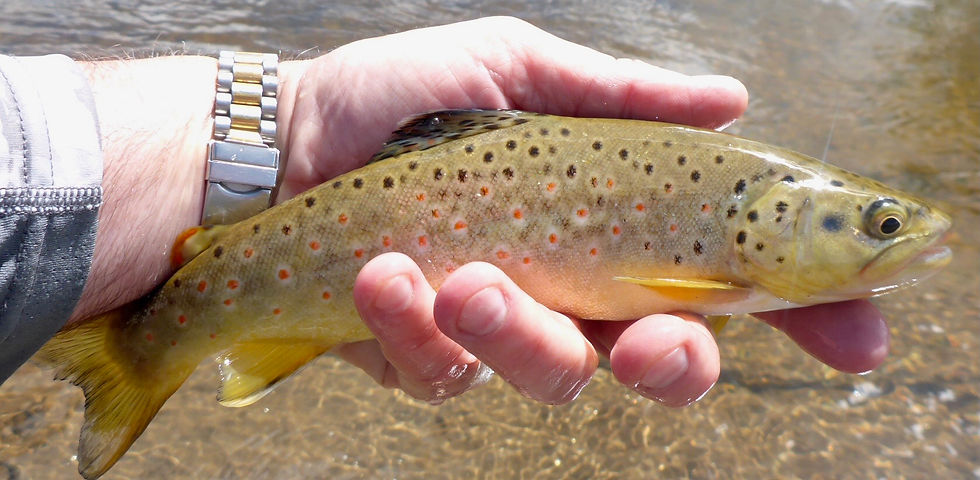
There were a couple of guys upstream of him panning for gold. They had quite an elaborate setup. From where I was, I had to cross a small section of water to get to where Brian was. This section is deep along the bank and there was a spillway just downstream of where I was crossing. As I was crossing, my net broke free and floated away. I heard a pop when my magnate broke loose of the net – but I never saw where my net went. But it had to have floated downstream.
As I was searching for my net, Brian was able to land a couple more brownies in the hole. They were hitting a #18 Red Copper John. I was pretty disgusted and told Brian I was going to head downstream toward the car. He suggested that I look for my net on the way. Which I did – but it was half-hearted. I have a hard time finding things when I know where they are – let alone finding a net that floated down the river.
The Red Copper John worked well for Brian at the end of the day.
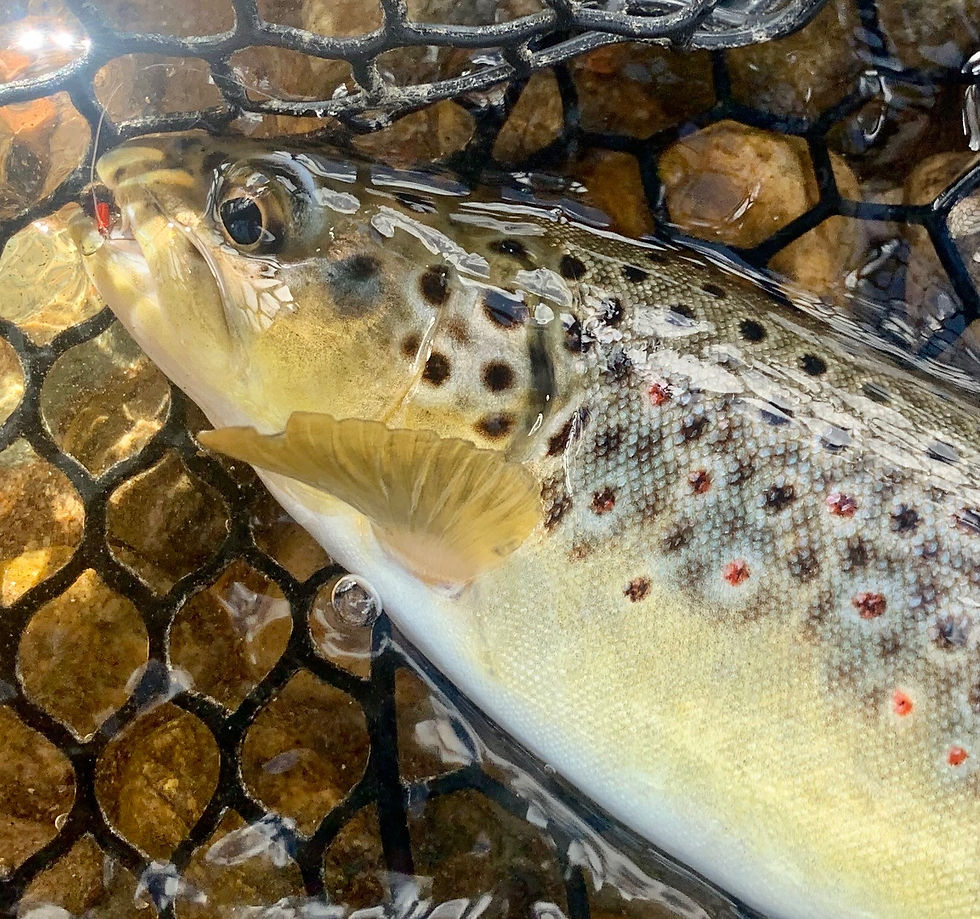
Brian Kenney.
But that’s not the same for Brian. He finds stuff all the time. I was thinking to myself “if anyone was going to find my net – it would be Brian”. And he did! About a ¼ mile downstream – almost to the car – he calls out “I found your net”. Unbelievable! It was stuck on tree branches that were sticking out of the water. Luckily, it was near the bank and I could reach it.
I was happy as we headed to the car. I was now whole again – I had all my stuff. A good way to end the day.
Can't get enough of this view!!

The Ark at Hayden Meadows is now in the books. A beautiful setting with the Sawatch Mountain Range – it’s snow capped 14,000’ peaks - to the west. A very difficult river to navigate with the slipperiest rocks known to man and smallish brownies – and some bigger ones with a stray rainbow or cutbow here and there.
A new experience – a fun place to fish, and to expand and hone your fishing skills.
Comments